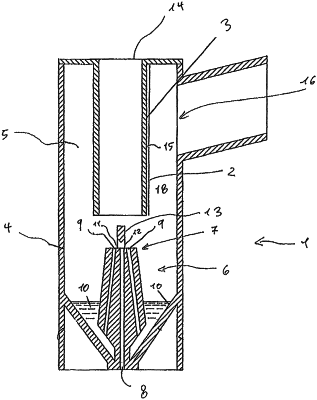|
1. A nebulizer comprising an aerosol generator, a nebulizing chamber, and an outlet, wherein the aerosol generator is configured to release an aerosol into the nebulizing chamber and the outlet is configured to allow removal of the aerosol from the nebulizing chamber, wherein a wetting surface is provided in the nebulizing chamber, said wetting surface being provided on a plastic component, wherein the wetting surface is configured to be wetted by the aerosol comprising a water-based liquid such that the liquid forms a contact angle of 90 degrees or less with the wetting surface, wherein the aerosol generator includes an annular aerosol guide defined by an inner wall comprising the wetting surface and an outer wall, wherein an effective cross-sectional area of the annular aerosol guide for delivery of the aerosol, when the wetting surface is wetted by the liquid, is increased in comparison with the annular aerosol guide not having the wetting surface and on which liquid is disposed, thereby increasing an output rate of the nebulizer, wherein the wetting surface comprises a fluorinated wetting surface formed directly on the plastic component and wherein hydrogen atoms of the plastic component have been replaced by fluorine atoms to form the fluorinated wetting surface.
|
